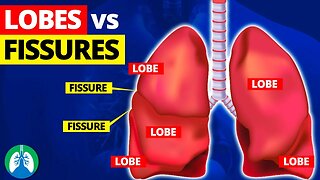What is Pneumonia? (Medical Definition)
What is Pneumonia? This video covers the basics of pneumonia and provides an overview of the medical definition.
💥Full Guide on Pneumonia ➜ ➜ ➜ https://bit.ly/2LXMg7b
➡️ Causes
Pneumonia has several different causes including viruses, bacteria, fungi, and even parasites in some cases.
➡️ Signs and Symptoms
The signs and symptoms of pneumonia can vary in severity from patient to patient. With that said, here are some of the most common examples:
▪ Productive cough
▪ Fever and chills
▪ Tachypnea
▪ Shortness of breath
▪ Chest pain
▪ Diaphoresis
▪ Fatigue
▪ Cyanosis
Keep in mind that other signs and symptoms of Pneumonia do exist. These are just some of the most common examples.
➡️ Types of Pneumonia
The type of pneumonia is often classified according to how the patient acquired the disease. Here are the different types:
▪ Community-Acquired Pneumonia (CAP)
▪ Hospital-Acquired Pneumonia (HAP)
▪ Ventilator-Associated Pneumonia (VAP)
▪ Aspiration Pneumonia
The name of each type pretty much gives away what it means:
▪ CAP is when a patient gets Pneumonia outside of the hospital.
▪ HAP is when the patient gets it during a hospital stay.
▪ VAP is when it’s acquired while the patient is on a mechanical ventilator.
▪ Aspiration Pneumonia is acquired when a patient aspirates bacteria into the lungs, usually from food, saliva, or stomach acid.
➡️ Diagnosis
Pneumonia is most commonly diagnosed by looking at the patient’s chest x-ray which will show signs of consolidation. Other tests and findings to look for include:
▪ Vital signs
▪ Arterial Blood Gas (ABG) results
▪ Pulmonary Function Tests (PFT)
▪ Sputum culture
▪ Complete Blood Count (CBC)
➡️ Treatment
Pneumonia should be treated on a case by case basis but, in general, here are the most common treatment methods:
▪ Antibiotic medications
▪ Oxygen therapy
▪ Bedrest
▪ Airway clearance therapy
▪ Hyperinflation therapy
▪ Fluid management
Now again, each patient will be treated differently depending on the cause and severity of symptoms. And in severe cases, intubation and mechanical ventilation would be indicated.
💥Full Guide on Pneumonia ➜ ➜ ➜ https://bit.ly/2LXMg7b
—————
📗 BEST STUDY GUIDES FOR YOU
▪ TMC Test Bank 👉 http://bit.ly/2IGeqSu
▪ Hacking the TMC Exam 👉 http://bit.ly/2XBc8do
▪ TMC Exam Bundle (Save $) 👉 https://bit.ly/34pqEsV
▪ Daily TMC Practice Questions 👉 http://bit.ly/2NnXh3C
💙MORE FROM RTZ
▪ Free TMC Practice Exam 👉 http://bit.ly/2XlwASL
▪ Free RRT Cheat Sheet 👉 http://bit.ly/2IbmOKB
▪ Resources for RT's 👉 http://bit.ly/2WVV5qo
▪ Testimonials 👉 http://bit.ly/2x7b5Gl
🌐FOLLOW US
▪ Instagram 👉 http://bit.ly/2FhF0jV
▪ Twitter 👉 http://bit.ly/2ZsS6T1
▪ Facebook 👉 http://bit.ly/2MSEejt
▪ Pinterest 👉 http://bit.ly/2ZwVLPw
🚑MEDICAL DISCLAIMER
Medicine and Respiratory Therapy are continuously changing practices. The information in this video is for educational and entertainment purposes only. For medical advice, please consult with a physician or qualified medical professional.
💡AFFILIATE DISCLAIMER
This description contains affiliate links. If you decide to purchase a product through one of them, we receive a small commission at no cost to you.
—————
⏰TIMESTAMPS
0:00 - Intro
0:20 - Causes
0:32 - Signs and Symptoms
1:02 - Types of Pneumonia
1:55 - Diagnosis
2:06 - Vital Signs
2:17 - Treatment
—————
🖼CREDIT FOR MUSIC AND GRAPHICS:
▪ Graphics: www.canva.com
▪ Graphics: www.freevector.com
▪ Graphics: www.vecteezy.com
▪ Graphics: www.pngtree.com
#Pneumonia #RespiratoryTherapy #RespiratoryTherapist #RespiratoryTherapySchool
-
 4:01
4:01
Respiratory Therapy Zone
5 months agoLung Lobes and Fissures *EXPLAINED* 🫁
177 -
 LIVE
LIVE
Benny Johnson
59 minutes agoSHOCK: Biden POOPS Pants On Stage At D-DAY Ceremony!? Jill DRAGS Wobbling Joe Away as World Cringes
3,486 watching -
 LIVE
LIVE
The Rubin Report
59 minutes agoI’m Calling Out Joe Rogan on This!
3,569 watching -
 LIVE
LIVE
LFA TV
4 hours agoTAKING TRUMP'S GUNS! | LIVE FROM AMERICA 6.6.24 11am EST
5,314 watching -
 24:01
24:01
Breaking Points
2 hours agoMorning Joe LOSES IT Over Biden Age Exposé
20912 -
 1:14:18
1:14:18
Michael Franzese
12 hours agoMichael Franzese LIVE! | Ep. 6
12K7 -
 1:27:53
1:27:53
Steven Crowder
1 hour agoDictator Dic-Off Evil 8: Crowning the Most Hardened Criminal in History
9.81K76 -
 1:46:20
1:46:20
Graham Allen
3 hours ago🚨Georgia POSTPONES Court Case!! Fani Willis Is DONE!! + Trump Drops VP List!!!!
21.2K124 -
 2:02:48
2:02:48
Matt Kohrs
13 hours agoGameStop Pushes Higher, Nvidia Smashes Records & Breaking News || The MK Show
13.1K5 -
 LIVE
LIVE
Major League Fishing
1 day agoLIVE Bass Pro Tour: Stage 5, Day 1
427 watching